I, and presumably most of the people reading my articles, are big fans of weight training and rigorous calisthenics. And who can blame us? Resistance training increases size and strength, makes you more physically capable, makes you more attractive to the opposite sex, increases production of androgens, and increases confidence and self-esteem.
But, like all physical activities, there is a risk of injury and long-term physical ailments-improper lifting technique can lead to blown out knees, rotator cuff injury, and slipped vertebral discs, but even relatively proper lifting can lead to repetitive stress injuries such as the ailment commonly known as “lifter’s shoulder”
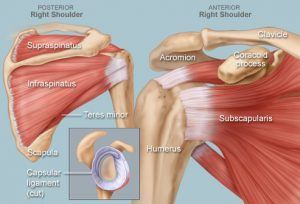
And even if you don’t have pain, the shoulders also bear a risk of getting “gorilla posture”-this occurs when a novice weightlifter focuses too much on the front of his torso (doing bench presses, overhead presses, push-ups, etc.) without properly training his back muscles and/or stretching the muscles of the chest, giving him shoulders that hunch inward despite their breadth.
Many, but certainly not all, lifters will find themselves with cracking and popping shoulders at the very least, and lingering shoulder pain at the worst. Those same lifters will often “Grit through” the pain, a futilely valiant gesture that sometimes leads to long term injury.
I myself have never had any serious injury from weightlifting, but I have suffered from cracking and popping shoulders. And, seeking a way to resolve this problem, I came across a series of stretches (and one calisthenic exercise) that can reduce pain in your shoulders
1. The Stick Stretch
The stick stretch (dubbed the shoulder dislocation on the Art of Manliness where I found this picture) is one that seems to be making the rounds on fitness websites and in magazines as of late, but I have always been one to not dismiss something just because it has grown in popularity-simply put, this stretch is great for your shoulder and pectoral mobility.
To do this stretch, get a pole, cane, broomstick, pipe, or some other rigid object of sufficient length (4-5 feet long is what I would reconmend). Take a hold of the pole with your palms facing outward. Keep your arms straight, lock your elbows, and SLOWLY lift the pole up and over your head, touch the back, and back over the head and touch your stomach.
Do 10 repetitions of this to start with, and increase later on. I would start out with as wide a grip as possible, and once you develop more flexibility, you can move your hands closer together-but remember to always keep your arms straight. Moving your arms around can lead to pulling of the pectoral muscle, which of course defeats the purpose of stretching.
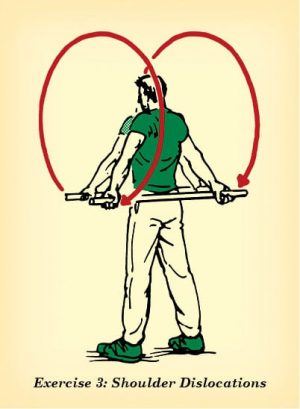
2. The Door Stretch
This is another stretch that targets the chest and shoulders, but in a different range of motion than the aforementioned stick stretch. For this stretch, stand slightly outside a door frame, straighten your arms, and reach them back behind you and grab the door frame.
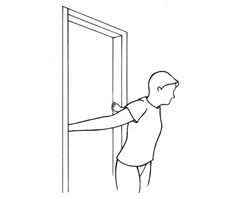
Then, keeping the body straight and erect, shift the weight forward and lean, while keeping a hold of the door frame. You will feel a stretch in your pectorals and shoulders. Hold the stretch for 10-20 seconds, and then lean back. Repeat if necessary.
3. The Chest Stretch
This is a stretch that I have discussed before (As have other writers in this genre), but it’s worth repeating-not the least because it requires absolutely no equipment whatsoever.
Stand up and put your feet together. Placing your hands on your hips, thrust the hips forward while looking up towards the ceiling. While keeping your balance, remove your hands from your hips and spread your arms out from your chest, keeping the arms straight and “opening” the chest as wide as possible.
The key to this stretch is to keep your arms straight while NOT locking your elbows-keep them “loose”. As usual, if you feel pain rather than a stretch, you’re doing it wrong.
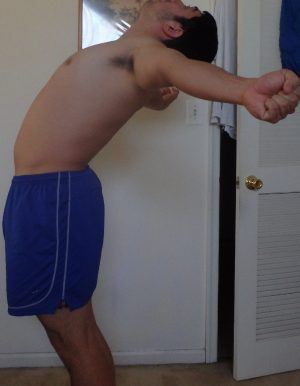
Those three stretches are quite effective for shoulder and chest mobility-indeed, doing these stretches 2-3 times a week will make your chest and shoulders look a little bit broader and improve your posture, and many will stop at this goal. But if you really want to strengthen the shoulder girdle and ensure that you won’t have rotator cuff injuries in the future, you’re going to want to utilize the timeless art of gymnastics.
4. “SKIN THE CAT”
Skinning the cat is a gymnastic static hold, that actually represents the first, most basic step of the back body lever.
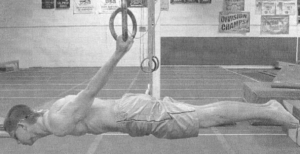
All of these holds will produce the same effect on your shoulders, but for the sake of ease, I will only instruct you on the easiest hold. Note that this is just a quick overview of the skill, and a full explanation of it (As well as steps to build up to it) will be for another article.
Grab a hold of a pull-up bar or a tree branch with the palms facing forward.
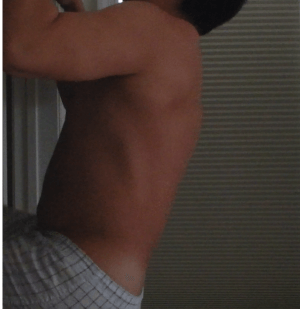
Then, using the strength of your abdominals, lift the feet up and pull them “through” the gap in your arms
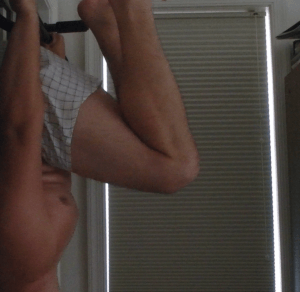
From here, I rotated through to parallel. The picture consisted of my ass sticking out of a door jamb, so I didn’t include it.
Continue rotating until you can’t rotate anymore (you’ll feel your arms stop rotating.) Your stomach will be parallel to the floor
And hold. You will likely only be able to do a few seconds at first, just rotate back before you lose your grip and fall flat on your face.
The first time I worked any sort of back lever, I immediately noticed a reduction in shoulder popping and cracking. In addition, the next day I felt the proverbial “soreness in muscles I didn’t know I had”.
Conclusion
If cracking shoulders can be considered an inevitability of weight training, lifters around the world should know that they can be overcome (or at the very least reduced). These four exercises can make great inroads in doing so.
Read More: 5 Ways To Improve High School Gym Class
Recommend stretch bands around your doorknob at varying colors to work your rotator cuff muscles and prevent impingement, really works.
Could you elaborate on this?
Ever since Senator “Dingy” Harry Reid and MLB prospect Matt Imhof both lost eyes reportedly due to elastic exercise bands I’ve been avoiding them like the plague.
Do you avoid crossing the street as well because people get hit by cars?
You need to be responsible and take care when doing any form of exercise. I have been using therabands for years without incident.
If you are really concerned just wear eye protection.
He may be referring to internal/external rotation using the bands to provide the resistance.
Cables and light dumbbells should do the trick too.
Wearing eye protection is a good idea. A friend used swimming goggles.
I’ve been doing all of these ever since my first bout of lifting tweaked something in my shoulders.
I seem to recall that the bridge (back-bend, whatever you call it) serves both to stretch and exercise. I think of it as a chest stretch plus tension.
Agree, bridging is excellent but can mess your back up if you overdo it.
I overdo exercises so that other people don’t have to.
Perfect timing on this article. Recently developed a shoulder click and slight left shoulder soreness for the first time after 25 years of lifting. Will try these out.
I currently make in the span of 6,000-8,000 dollars every month on the internet. Anyone considering to work easy freelance tasks for 2h-5h /day at your home and make solid checks while doing it… This is ideal for you… http://2.gp/G8zm
dgdsf
Thanks for the tips. I tore my AC joint a while back this is good info for me.
Welcome to the AC Injury Club.
If it is gonna hurt anyway, have some fun with it
Retract and drop the scapula on all pressing movments! Save the rotator cuffs please!!
I learned this about three months ago. 20 years too late.
Rotator Cuff memeber here. 1 year of frozen shoulder weak shoulder muscles and complete mental frustration.
Welcome to my world. First frozen shoulder on left side, got much better with painful rehab, then right side starting acting up. MRI shows 50% torn rotator. But I’m no spring chicken and have lots of wear and tear on me via years in Army, sports, and then manual labor jobs.
Get better, brah.
So true.
Retracted shoulders are a rarity everywhere I train, and the rotator cuffs are not the only unhappy ones for it.
I have to say, I cannot recommend stretching for shoulder injuries. I have had one myself and the bulk of my physio involved mobility work. In my opinion, excessive stretching will lead to worse shoulder stability not better.
I recommend light (by light I mean light!!!) asymmetric cable training along a number of different planes. This will be therapeutic if kept below the pain threshold. This will strengthen the fine muscles and tendons in your shoulder and help reduce inflammation.
Once the tenderness is gone you can begin shoulder strengthening work. Asymmetric work with kettlebells is great for this.
Frankly, in my opinion, once you have a shoulder injury, two handed barbell work is over for you. You don’t need it anyway. And for Heaven’s Sake, stop doing dips! Terrible for your shoulders.
Good luck guys!
Thank you. I would have distinguished between unsupervised “amateur” stretches and well learned “professional” stretches (incredible how mobile shoulders are and how just a few degrees can destroy the right angle of a “simple” stretch), but in my opinion, you are correct.
I agree completely, after my shoulder injury I realised my barbell days were over. Especially the bench press and overhead shoulder press. Most shoulder injuries stem from bad technique, lifting too much weight and over training. I agree that cable training is a good way to help your shoulders as well as working on your lats. Strong lats help to pull everything in and stabilise your shoulders.
OH barbell presses are well-known for injuring shoulders.
The “reverse fly” seems to be very effective for shoulder imbalances.
http://ergo-log.com/this-exercise-protects-against-shoulder-injury.html
Makes perfect sense. In our modern world we are chronically making pushing movements (i.e. when we type on keyboards), so it makes that reversing that motion with reverse flies would be beneficial.
Thanks for the tip!
NP. After I add significantly more weight/total load to my overhead press I’ll probably start incorporating them in.
One study in china tested boron to treat fluorosis. The number one symptom reduction was shoulder pain. I tried a very aggressive amount of it and had an 85 percent reduction of pain in 3 days. I could bench again.
Larsen, another great article. I have AC Joint osteolysis. I do stick stretches and it does help. When I have flair ups I avoid bench pressing all together. Every lifestyle has its injuries and setbacks. I have herniated discs at L1, L3-S1, L5 with nerve impingement and there are days when even standing up hurts. IT is all about weighing the pros and cons.
You’ve convinced me that exercising is far too dangerous. I think I’ll stick to sitting on the couch, watching TV. What could possibly go wrong?
–said every single person 50 pounds overweight ever
I like the way you think. 😉
I had a long standing shoulder issue that was partially cured by a steroid injection from the doc. I highly recommend using a roller pre workout. I rolled my shoulder blades, upper back, and lats. Its amazing how tight and painful your lats are and they greatly affect the shoulder. As somebody else said, light cable training is also really good.
I injured my shoulder (symptoms seem to most closely fit what’s called shoulder impingement, didn’t get an accurate diagnosis from my doctor) in an overhead dumbbell press more than six months ago.
I didn’t make much recovery progress in the first three months (kept working out very lightly with primarily body weight exercises) but I started improving pretty quickly once I incorporated The Stick Stretch on a daily basis, along with internal shoulder rotations (I do them standing with an elastic band, the more traditional way is lying on your side with a dumbbell).
Almost rid of the pain now, although I’m holding off on heavy overhead lifts for a while still. A bonus to my partial workout downtime is that I’ve grown great appreciation for many body weight exercises – even the basics like push-ups can be made much tougher with its many variations – and since I’ve definitely been much more prone to minor injuries and joint pains since my mid 30s (40 now) than when I was younger, I’ll probably switch much of my workout regiment permanently to calisthenics, with some dumbbell supplement.
Heavy volume in overhead presses and shoulder impingement are famous bedfellows.
Props to your rehab and newly discovered love for calisthenics.
Boron 10mg/day does miracles for shoulder pain.
once you fk a shoulder, you better heal it. If the shoulder locks up you wont be able to zipper your fly… The older you get the more likely you are to wear out a shoulder in some way. The trick to treat your shoulders like they are not replaceable. Unless you are a professional weight lifter, dont go a killing your arms with crazy weights. I can write my own article on the shoulder situation. Bad shoulders are a current epidemic and every case is different.